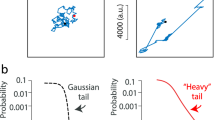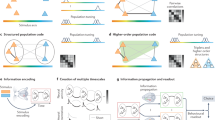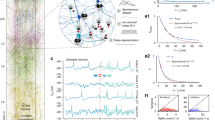Abstract
Perception, cognition and behavior rely on flexible communication between microcircuits in distinct cortical regions. The mechanisms underlying rapid information rerouting between such microcircuits are still unknown. It has been proposed that changing patterns of coherence between local gamma rhythms support flexible information rerouting. The stochastic and transient nature of gamma oscillations in vivo, however, is hard to reconcile with such a function. Here we show that models of cortical circuits near the onset of oscillatory synchrony selectively route input signals despite the short duration of gamma bursts and the irregularity of neuronal firing. In canonical multiarea circuits, we find that gamma bursts spontaneously arise with matched timing and frequency and that they organize information flow by large-scale routing states. Specific self-organized routing states can be induced by minor modulations of background activity.
This is a preview of subscription content, access via your institution
Access options
Access Nature and 54 other Nature Portfolio journals
Get Nature+, our best-value online-access subscription
$29.99 / 30 days
cancel any time
Subscribe to this journal
Receive 12 print issues and online access
$209.00 per year
only $17.42 per issue
Buy this article
- Purchase on Springer Link
- Instant access to full article PDF
Prices may be subject to local taxes which are calculated during checkout






Similar content being viewed by others
References
Olshausen, B.A., Anderson, C.H. & Van Essen, D.C. A neurobiological model of visual attention and invariant pattern recognition based on dynamic routing of information. J. Neurosci. 13, 4700–4719 (1993).
Vogels, T.P. & Abbott, L.F. Gating multiple signals through detailed balance of excitation and inhibition in spiking networks. Nat. Neurosci. 12, 483–491 (2009).
Zylberberg, A., Fernández Slezak, D., Roelfsema, P.R., Dehaene, S. & Sigman, M. The brain's router: a cortical network model of serial processing in the primate brain. PLoS Comput. Biol. 6, e1000765 (2010).
Abeles, M., Hayon, G. & Lehmann, D. Modeling compositionality by dynamic binding of synfire chains. J. Comput. Neurosci. 17, 179–201 (2004).
Kumar, A., Rotter, S. & Aertsen, A. Conditions for propagating synchronous spiking and asynchronous firing rates in a cortical network model. J. Neurosci. 28, 5268–5280 (2008).
Hahn, G., Bujan, A.F., Frégnac, Y., Aertsen, A. & Kumar, A. Communication through resonance in spiking neuronal networks. PLoS Comput. Biol. 10, e1003811–e1003816 (2014).
Akam, T. & Kullmann, D.M. Oscillations and filtering networks support flexible routing of information. Neuron 67, 308–320 (2010).
Harnack, D., Ernst, U.A. & Pawelzik, K.R. A model for attentional information routing through coherence predicts biased competition and multistable perception. J. Neurophysiol. 114, 1593–1605 (2015).
Fries, P. A mechanism for cognitive dynamics: neuronal communication through neuronal coherence. Trends Cogn. Sci. 9, 474–480 (2005).
Gregoriou, G.G., Gotts, S.J., Zhou, H. & Desimone, R. High-frequency, long-range coupling between prefrontal and visual cortex during attention. Science 324, 1207–1210 (2009).
Grothe, I., Neitzel, S.D., Mandon, S. & Kreiter, A.K. Switching neuronal inputs by differential modulations of gamma-band phase-coherence. J. Neurosci. 32, 16172–16180 (2012).
Burns, S.P., Xing, D. & Shapley, R.M. Is gamma-band activity in the local field potential of V1 cortex a “clock” or filtered noise? J. Neurosci. 31, 9658–9664 (2011).
Xing, D. et al. Stochastic generation of gamma-band activity in primary visual cortex of awake and anesthetized monkeys. J. Neurosci. 32, 13873–13880a (2012).
Jia, X., Tanabe, S. & Kohn, A. γ and the coordination of spiking activity in early visual cortex. Neuron 77, 762–774 (2013).
Ray, S. & Maunsell, J.H.R. Do gamma oscillations play a role in cerebral cortex? Trends Cogn. Sci. 19, 78–85 (2015).
Ray, S. & Maunsell, J.H.R. Differences in gamma frequencies across visual cortex restrict their possible use in computation. Neuron 67, 885–896 (2010).
Jia, X., Xing, D. & Kohn, A. No consistent relationship between gamma power and peak frequency in macaque primary visual cortex. J. Neurosci. 33, 17–25 (2013).
Okun, M. et al. Diverse coupling of neurons to populations in sensory cortex. Nature 521, 511–515 (2015).
Brunel, N. & Hakim, V. Fast global oscillations in networks of integrate-and-fire neurons with low firing rates. Neural Comput. 11, 1621–1671 (1999).
Brunel, N. & Wang, X.-J. What determines the frequency of fast network oscillations with irregular neural discharges? I. Synaptic dynamics and excitation-inhibition balance. J. Neurophysiol. 90, 415–430 (2003).
Bartos, M., Vida, I. & Jonas, P. Synaptic mechanisms of synchronized gamma oscillations in inhibitory interneuron networks. Nat. Rev. Neurosci. 8, 45–56 (2007).
Roberts, M.J. et al. Robust gamma coherence between macaque V1 and V2 by dynamic frequency matching. Neuron 78, 523–536 (2013).
Bastos, A.M., Vezoli, J. & Fries, P. Communication through coherence with inter-areal delays. Curr. Opin. Neurobiol. 31, 173–180 (2015).
Chakrabarti, S., Martinez-Vazquez, P. & Gail, A. Synchronization patterns suggest different functional organization in parietal reach region and dorsal premotor cortex. J. Neurophysiol. 112, 3138–3153 (2014).
Buschman, T.J. & Miller, E.K. Top-down versus bottom-up control of attention in the prefrontal and posterior parietal cortices. Science 315, 1860–1862 (2007).
Schreiber, T. Measuring information transfer. Phys. Rev. Lett. 85, 461–464 (2000).
Wibral, M., Vicente, R. & Lizier, J.T. Directed Information Measures in Neuroscience (Springer, 2014).
Bosman, C.A. et al. Attentional stimulus selection through selective synchronization between monkey visual areas. Neuron 75, 875–888 (2012).
Grothe, I. et al. Attention selectively gates afferent signal transmission to area V4. Preprint at https://doi.org/10.1101/019547 (2015).
Somers, D. & Kopell, N. Rapid synchronization through fast threshold modulation. Biol. Cybern. 68, 393–407 (1993).
Mazzoni, A., Panzeri, S., Logothetis, N.K. & Brunel, N. Encoding of naturalistic stimuli by local field potential spectra in networks of excitatory and inhibitory neurons. PLoS Comput. Biol. 4, e1000239 (2008).
Kreiter, A.K. & Singer, W. Stimulus-dependent synchronization of neuronal responses in the visual cortex of the awake macaque monkey. J. Neurosci. 16, 2381–2396 (1996).
Ecker, A.S. et al. Decorrelated neuronal firing in cortical microcircuits. Science 327, 584–587 (2010).
Canolty, R.T. et al. Oscillatory phase coupling coordinates anatomically dispersed functional cell assemblies. Proc. Natl. Acad. Sci. USA 107, 17356–17361 (2010).
Witt, A. et al. Controlling the oscillation phase through precisely timed closed-loop optogenetic stimulation: a computational study. Front. Neural Circuits 7, 49 (2013).
Tiesinga, P.H. & Sejnowski, T.J. Mechanisms for phase shifting in cortical networks and their role in communication through coherence. Front. Hum. Neurosci. 4, 196 (2010).
Battaglia, D., Brunel, N. & Hansel, D. Temporal decorrelation of collective oscillations in neural networks with local inhibition and long-range excitation. Phys. Rev. Lett. 99, 238106 (2007).
Burkhalter, A. Many specialists for suppressing cortical excitation. Front. Neurosci. 2, 155–167 (2008).
Battaglia, D., Witt, A., Wolf, F. & Geisel, T. Dynamic effective connectivity of inter-areal brain circuits. PLoS Comput. Biol. 8, e1002438 (2012).
Dotson, N.M., Salazar, R.F. & Gray, C.M. Frontoparietal correlation dynamics reveal interplay between integration and segregation during visual working memory. J. Neurosci. 34, 13600–13613 (2014).
Osborne, L.C., Palmer, S.E., Lisberger, S.G. & Bialek, W. The neural basis for combinatorial coding in a cortical population response. J. Neurosci. 28, 13522–13531 (2008).
Rigotti, M. et al. The importance of mixed selectivity in complex cognitive tasks. Nature 497, 585–590 (2013).
Harris, K.D., Csicsvari, J., Hirase, H., Dragoi, G. & Buzsáki, G. Organization of cell assemblies in the hippocampus. Nature 424, 552–556 (2003).
Buzsáki, G. Neural syntax: cell assemblies, synapsembles, and readers. Neuron 68, 362–385 (2010).
Salazar, R.F., Dotson, N.M., Bressler, S.L. & Gray, C.M. Content-specific fronto-parietal synchronization during visual working memory. Science 338, 1097–1100 (2012).
Lisman, J. The theta/gamma discrete phase code occuring during the hippocampal phase precession may be a more general brain coding scheme. Hippocampus 15, 913–922 (2005).
Colgin, L.L. et al. Frequency of gamma oscillations routes flow of information in the hippocampus. Nature 462, 353–357 (2009).
Cannon, J. et al. Neurosystems: brain rhythms and cognitive processing. Eur. J. Neurosci. 39, 705–719 (2014).
Hipp, J.F., Hawellek, D.J., Corbetta, M., Siegel, M. & Engel, A.K. Large-scale cortical correlation structure of spontaneous oscillatory activity. Nat. Neurosci. 15, 884–890 (2012).
Bastos, A.M. et al. Visual areas exert feedforward and feedback influences through distinct frequency channels. Neuron 85, 390–401 (2015).
Wang, X.J. & Buzsáki, G. Gamma oscillation by synaptic inhibition in a hippocampal interneuronal network model. J. Neurosci. 16, 6402–6413 (1996).
Golomb, D. & Rinzel, J. Clustering in globally coupled inhibitory neurons. Physica D 72, 259–282 (1994).
Golomb, D. & Hansel, D. The number of synaptic inputs and the synchrony of large, sparse neuronal networks. Neural Comput. 12, 1095–1139 (2000).
Vicente, R., Wibral, M., Lindner, M. & Pipa, G. Transfer entropy--a model-free measure of effective connectivity for the neurosciences. J. Comput. Neurosci. 30, 45–67 (2011).
Wibral, M. et al. Measuring information-transfer delays. PLoS One 8, e55809 (2013).
Gourévitch, B. & Eggermont, J.J. Evaluating information transfer between auditory cortical neurons. J. Neurophysiol. 97, 2533–2543 (2007).
Honey, C.J., Kötter, R., Breakspear, M. & Sporns, O. Network structure of cerebral cortex shapes functional connectivity on multiple time scales. Proc. Natl. Acad. Sci. USA 104, 10240–10245 (2007).
Lungarella, M., Pitti, A. & Kuniyoshi, Y. Information transfer at multiple scales. Phys. Rev. E 76, 056117 (2007).
Garofalo, M., Nieus, T., Massobrio, P. & Martinoia, S. Evaluation of the performance of information theory-based methods and cross-correlation to estimate the functional connectivity in cortical networks. PLoS One 4, e6482 (2009).
Ito, S. et al. Extending transfer entropy improves identification of effective connectivity in a spiking cortical network model. PLoS One 6, e27431 (2011).
Stetter, O., Battaglia, D., Soriano, J. & Geisel, T. Model-free reconstruction of excitatory neuronal connectivity from calcium imaging signals. PLoS Comput. Biol. 8, e1002653 (2012).
Orlandi, J.G., Stetter, O., Soriano, J., Geisel, T. & Battaglia, D. Transfer entropy reconstruction and labeling of neuronal connections from simulated calcium imaging. PLoS One 9, e98842 (2014).
Vakorin, V.A., Krakovska, O.A. & McIntosh, A.R. Confounding effects of indirect connections on causality estimation. J. Neurosci. Methods 184, 152–160 (2009).
Strong, S., Koberle, R., de Ruyter van Steveninck, R. & Bialek, W. Entropy and information in neural spike trains. Phys. Rev. Lett. 80, 197 (1998).
Cover, T.M. & Thomas, J.A. Elements of Information Theory 2nd edn. (Wiley-Interscience, 2006).
Frenzel, S. & Pompe, B. Partial mutual information for coupling analysis of multivariate time series. Phys. Rev. Lett. 99, 204101 (2007).
Acknowledgements
We thank U. Ernst, C.M. Gray, A. Kreiter, K. Pawelzik and R. Shapley for discussions. This work was partially supported by the Federal Ministry for Education and Research (BMBF) under grant no. 01GQ1005B (to A.P., T.G., F.W. and D.B.), by a GGNB Excellence Stipend of the University of Göttingen (to A.P.), through CRC 889 by the Deutsche Forschungsgemeinschaft and by the VolkswagenStiftung under grant no. ZN2632 (to F.W.), and by the FP7 Marie Curie career development fellowship IEF 330792 (DynViB) (to D.B.).
Author information
Authors and Affiliations
Contributions
A.P. performed the simulations of the models and analyzed the results; A.P., F.W. and D.B. conceived the study, designed models and developed analysis pipelines; A.P., T.G., F.W. and D.B. wrote the paper. All authors discussed the results and implications.
Corresponding authors
Ethics declarations
Competing interests
The authors declare no competing financial interests.
Supplementary information
Supplementary Text and Figures
Supplementary Figures 1–18 (PDF 3900 kb)
Rights and permissions
About this article
Cite this article
Palmigiano, A., Geisel, T., Wolf, F. et al. Flexible information routing by transient synchrony. Nat Neurosci 20, 1014–1022 (2017). https://doi.org/10.1038/nn.4569
Received:
Accepted:
Published:
Issue Date:
DOI: https://doi.org/10.1038/nn.4569
This article is cited by
-
Gamma oscillatory complexity conveys behavioral information in hippocampal networks
Nature Communications (2024)
-
Chaos shapes transient synchrony activities and switchings in the excitatory-inhibitory networks
Nonlinear Dynamics (2024)
-
Robust encoding of natural stimuli by neuronal response sequences in monkey visual cortex
Nature Communications (2023)
-
An oscillatory mechanism for multi-level storage in short-term memory
Communications Biology (2023)
-
Brain network communication: concepts, models and applications
Nature Reviews Neuroscience (2023)



